30 June 2016, 15:28
Signs of readiness to introduce complementary foods:
Complementary feeding is not introduced upon reaching a certain age - age is only one of the factors. Readiness can only be judged by the presence of a combination of factors:
1. At least 4 months old. (for children who were born ahead of schedule, based on gestational age).
2. The child has doubled his weight since birth. For premature babies, the coefficient is x2.5.
3. The child’s tongue thrust reflex has disappeared. If you give him something to drink from a spoon, then its contents will not end up on the chin (and we give complementary foods EXCLUSIVELY from a spoon so that it is treated with saliva).
4. The child knows how to sit. May lean the body towards the spoon or lean back, refusing to eat. Able to control the turn of his head - he can turn away in case of refusal. Or tilt your head.
5. If he is artificial, then he eats more than a liter of formula a day and does not get enough. If on breastfeeding, then at each feeding she eats both breasts and really wants more.
6. A child can hold something in his fist and purposefully put it in his mouth.
7. And most importantly, children show a HUGE interest in their parents’ food and are eager to try it. Nature itself lets you know when the child’s body is already able to accept food other than the adapted one (formula or mother’s milk).
For each child, this period, when ALL readiness factors have already been demonstrated, comes individually. On average between 5 and 9 months. By the way, even twins can show signs differently. There are situations when a child shows all signs of readiness already at 4 months, and there are situations when a child can wait up to a year - but these are more extreme situations, although they are also a variant of the norm.
Therefore, DO NOT Rush with complementary foods. It’s better to be “a little” late than to rush. If the child has good adequate nutrition ( breast milk or good adapted mixture) – he will not be deprived of a source of nutrients.
Basic rules for introducing complementary foods· Start introducing complementary foods only to a healthy child or, as a last resort, during the recovery period, with normal stools;
· complementary foods are introduced warm before breastfeeding or formula feeding;
· complementary foods are given from a spoon, vegetable puree can be first added to a bottle of milk so that the child gets used to the new taste more easily;
· each complementary feeding dish is introduced gradually, from small quantities (1-2 teaspoons) and is brought up to the age-specific dose within two weeks;
· they switch to a new type of complementary feeding 1.5-2 weeks after the introduction of the previous one;
· the density of complementary foods should gradually increase;
/>
Complementary foods - vegetables
Important point!!! The first vegetable should be “typical of the family and area”. A baby from Egypt will be sick of eating peas as complementary food, but will tolerate an orange perfectly. For which the “average Ukrainian” will be treated for years.
For example, carrots in Germany are considered a hypoallergenic product. The "bright color" theory is considered a myth. It is not recommended to give squash and turnips until one is a year old... and celery and carrots are considered the best solution for first complementary feeding. The same pumpkin - the best variety is considered to be "Hokaido" - a bright red small pumpkin.
Be sure to look at the label to ensure that no spices, salt, or rice starch are added to the puree. This is very important! The first puree (and subsequent ones, by the way, too) should contain nothing except vegetables and water
How to give:
· Gradually the volume is increased to 50-100 ml, making sure that everything is in order, you can try giving another vegetable. The rules for administration are the same, starting with a small amount, the volume of puree offered to the child is gradually increased.
· do not give two new vegetables at once, only mono puree. About a couple of months after introducing vegetables, you can start giving your child vegetable oil, adding a small amount to vegetable puree. It is very useful to give oils obtained by the “cold” method, as they contain polyunsaturated fatty acids that have a beneficial effect on the condition of the skin. Flaxseed oil is rich in such acids.
· To reduce a possible allergic or other reaction to vegetables to a minimum, you need to introduce vegetables (and any other product) as carefully as possible, especially if the baby is prone to diathesis, allergies, constipation, diarrhea, etc.
· Offer a new vegetable at the end of feeding, if possible mix it with old familiar food to the child. If you are breastfeeding, then let your baby take each new complementary food with the breast (at his request, of course), this will help the baby digest and assimilate a new product for his gastrointestinal tract. If the baby is on artificial feeding, then it is optimal to give a little familiar mixture after introducing a new product. If this is not the baby’s first complementary food, then mix the vegetable with “old” (familiar to the child) food.
· The smaller doses you start with complementary feeding, the better. The smaller the initial amount of vegetables, the slower it increases, the less likely it is for diathesis to occur.
Homemade vegetables
If you don’t have enough money for store-bought jars, or you have some kind of prejudice against them, you can prepare vegetable puree for your baby yourself - either from frozen vegetables or from fresh vegetables. It depends on the time of year - if it’s autumn, the season of vegetables, then you will certainly prepare puree from fresh market vegetables, if there are no vegetables on sale, then buy frozen vegetables in bags and prepare puree from them.
If you have a blender, that’s great! Prepare cauliflower, zucchini, pumpkin or turnips as usual and cook for yourself (the only difference is that for yourself you add salt and spices, and for your baby you simply cook vegetables in water). Then cool the vegetables a little and grind them in a blender. The only exception is potatoes - it is not recommended to grind them in a blender, because the starch in them will turn the puree into a sticky paste, not much like tender mashed potatoes.
When you introduce mono-puree from fresh or frozen vegetables, you can make a variety of variations from the puree, depending on the baby’s taste and his discretion: cook carrots, potatoes, cauliflower. Cook together peas, peppers, tomatoes and potatoes, etc. There are many options!
As your baby gets older, you don’t have to grind vegetable puree in a blender - it will be enough to just mash soft boiled vegetables with a fork (the baby will learn to eat in pieces, and since vegetables are usually soft, it will be easier for the baby to get used to eating in pieces).
If you don’t trust not only jarred baby food, but also frozen vegetables, then you can freeze the vegetables yourself for future use. They can be stored at a temperature of – 6°C for a week, at – 12° C for 1 month, at – 18° C for 3 months.
· the second complementary food - cereal porridges - you need to start introducing them with gluten-free porridges (rice, corn, buckwheat) and cook them with the milk or formula that the child receives;
· baby food in jars contains the optimal amount of salt and sugar and therefore should not be added.
/>
Complementary foods - porridge.
The first porridge for a baby must be gluten-free - rice, buckwheat or corn porridge (by the way, one of the components of ordinary corn porridge is corn starch, which is 80% gluten). Therefore, when we talk about corn porridge, we mean industrially produced porridge specifically for children, and not ground corn, which is also called “polenta”). Other porridges: oatmeal, semolina, millet, barley, etc. – contain gluten and are not suitable as a first complementary food.
It is best to cook porridge in water, but it is allowed, if the baby is breastfed, to cook porridge with expressed mother’s milk. The same applies to artificial ones - it is permissible to cook porridge with the mixture that the baby usually consumes.
If your baby has a tendency to constipation, then it is advisable to start complementary feeding not with rice porridge. Best with buckwheat. Although they say that buckwheat is very allergenic, this needs to be determined by the child. If you are prone to allergies, then start complementary feeding with rice; if you have constipation, then start with buckwheat. If you are prone to allergies and constipation at the same time, then start complementary feeding with corn, and then introduce oatmeal.
If the baby does not have any problems, then it can be administered in this order - rice, buckwheat, corn or buckwheat, rice, corn. After these porridges are introduced, you can try oatmeal porridge. Semolina porridge, due to its high nutritional value, but low vitamin content and usefulness, is better to postpone until later and offer it to the baby after a year
Table with dairy-free, milk and fruit-grain porridges:
How to give?
Under no circumstances should you give it to yourself small child porridge from a bottle. It’s better to make thin porridge and give it from a spoon, let the baby eat a little, but eat it right! For a baby, the amount of food at the first feeding is not so important; for him, it is still only an introductory, trial, and not satiating. When feeding from a bottle, food does not undergo enzymatic processing of saliva, which negatively affects the digestive process. The fact is that the baby’s saliva contains special enzymes – amylase and lysozyme. When food enters the baby’s mouth from a spoon, it manages to be completely, so to speak, saturated with saliva, and enters the stomach already thoroughly “soaked” with saliva. And amylase greatly promotes digestion and breakdown of food. Already in the stomach, it helps to quickly break down food into smaller components and thereby promotes faster digestion. When a baby is given food from a bottle, it does not have time to become saturated with saliva and almost immediately goes into the throat, without lingering in the mouth. Thus, it enters the stomach without primary treatment with amylase.
To reduce a possible allergic or other reaction to porridge to a minimum, you need to introduce porridge (and any other product) as carefully as possible, especially if the baby is prone to diathesis, allergies, constipation, diarrhea, etc.
Offer a new porridge at the end of feeding, if possible mix it with old familiar food to the child. If you are breastfeeding, then let your baby take each new complementary food with the breast (at his request, of course), this will help the baby digest and assimilate a new product for his gastrointestinal tract. If the baby is bottle-fed, then it is optimal to give a little familiar mixture after introducing a new product. If this is not the baby’s first complementary food, then mix the porridge with “old” (familiar to the child) food.
This is done to prepare the gastrointestinal tract for new food, so that it is easier for the enzymatic systems, intestines, and stomach to work, digesting “familiar food.” By introducing complementary foods at the end of feeding, you will not “take the child by surprise” and will not harm him.
The smaller doses you start with complementary feeding, the better. The smaller the initial amount of porridge, the slower it increases, the less likely it is for diathesis to occur.
When to give?
The introduction of porridge into a baby’s diet depends only on the baby himself and his mother. Traditionally, if the baby is underweight, if the baby is thin, then it is advisable to start complementary feeding with cereals.If the baby is chubby, if he has a slight (or large) excess weight, then it is best to start complementary feeding for such a baby with mono-vegetable puree.
The time of day for introducing porridge is not of fundamental importance. Traditionally, porridge is given either in the morning or for dinner. But for the first feeding, it is better to choose the morning time in order to see during the day what the baby’s reaction to the new product will be. If you give a new product at night, you may not notice it. When you have already introduced porridge into your child’s diet and are sure that the baby reacts normally to it, you can give the porridge at night (or leave it like that in the morning).
/>
Fruits
Fruit purees are best administered after cereals and vegetables. If you have already introduced porridge and vegetables to your baby, then it’s time to let your child try fruit puree.
For the first complementary feeding, it is necessary to take foods with a low degree of allergenicity - these are green apples, white cherries, white currants, gooseberries, plums. When low-allergenic vegetables are introduced, you can introduce “medium-allergenic” vegetables, such as peaches, apricots, red currants, bananas, and cranberries. And you need to leave highly allergenic foods, such as strawberries, raspberries, wild strawberries, black currants, blackberries, pineapple, grapes, melon, persimmon, pomegranate, citrus fruits and others, until the very end.
After the first complementary feeding with mono-fruits has been introduced, you can offer the child an assorted puree of different fruits. There are a lot of such purees!
How to give?
· Complementary foods are introduced starting with a quarter of a teaspoon once a day, preferably in the first half of the day. Every day the volume increases gradually, approximately 2 times. It is brought up to the age norm in 7 – 10 days. The condition of the child’s skin and digestive problems are assessed daily; if any changes appear, the introduction of complementary foods is suspended.
· Gradually the volume is increased to 50-100 ml (on average 70 grams in the first complementary feeding, then increases to 100 g, and then to 180 g), after making sure that everything is in order, you can try giving another fruit. The rules for administration are the same, starting with a small amount, the volume of puree offered to the child is gradually increased.
· General rule for ANY complementary foods - no more than one product every 1-2 weeks!
· Do not give two new fruits at once, only mono puree.
· To reduce a possible allergic or other reaction to fruits to a minimum, you need to introduce fruits (and any other product) as carefully as possible, especially if the baby is prone to diathesis, allergies, constipation, diarrhea, etc.
· Offer a new fruit at the end of feeding, if possible mix it with old familiar food to the child. If you are breastfeeding, then let your baby take each new complementary food with the breast (at his request, of course), this will help the baby digest and assimilate a new product for his gastrointestinal tract. If the baby is bottle-fed, then it is optimal to give a little familiar mixture after introducing a new product. If this is not the baby’s first complementary food, then mix the fruit with “old” (familiar to the child) food.
· This is done to prepare the gastrointestinal tract for new food, so that it is easier for the enzymatic systems, intestines, and stomach to work, digesting “familiar food.” By introducing complementary foods at the end of feeding, you will not “take the child by surprise” and will not harm him.
· The smaller doses you start with complementary feeding, the better. The smaller the initial amount of fruit, the slower it increases, the less likely it is for diathesis to occur.
/>
COMPLEMENTARY FEEDING SCHEME FROM GASTROENTEROLOGIST
Give each new product for at least 7 days. Start with 1 tsp. and bring it back to normal within a week.
6 months
At about 12 noon (future lunch) – vegetables.
“Squash” (zucchini-pumpkin) is still a type of pumpkin, and not our stripe - don’t give it away.
Remove pumpkin and carrots.
Leave everything yellow for later. Start with green.
You can cook it yourself or make puree from frozen vegetables.
Zucchini – frozen. For example, the company "4 seasons"
Cauliflower – “Semper” or frozen
Broccoli – “Semper”, “Top-top” (not to be confused with “Tip-top”)
Green beans - make your own
Green peas – “Gerber”
Potatoes – “Gerber” ordinary, don’t give sweet ones, (also not our stripe), do it yourself (before soaking for 2 hours in boiled cold water, when starch is released, change the water)
Parsnips and spinach - after a year, because reduces the level of iron absorption in the child’s body by more than 76%
When you try everything, you can mix, but no more than 3 types.
Vegetable oil from 8 months.
7 months
Gradually completely replace one feeding.
Buckwheat, corn, rice without additives.
Oatmeal, semolina, milk, and soy porridges are not included in the diet for up to a year. It's harmful.
The packaging should say: “no sugar, salt, gluten, milk, dyes.”
It is best to give it in water, since with the addition of milk there is a greater burden on the gastrointestinal tract.
“Gerber”, “Baby Sitter”, “Low-allergenic Baby”
7 months
At 17:00 (future afternoon snack) – fruits:
Green apple – “Semper”, “Top-top”. Bake it yourself.
Red later.
Pear - (if there is no constipation) “Semper”.
Banana - make it yourself.
Apricots, peaches - jars, do it yourself in the summer, do not water them with anything harmful,
As for cherries and cherries, do it yourself later in the summer.
Cottage cheese - after 8 months. For an afternoon snack, add to fruit puree.
For example, 0% cottage cheese “House in the Village”. Every day a new pack.
Strictly no more than the norm; if a child is overfed with cottage cheese, he will develop anorexia.
Meat - after 12 m. (load on the gastrointestinal tract) add to vegetable puree. Do not exceed the meat norm! Strictly prepared purees with vegetables.
“Gerber” – turkey, pig, lamb, beef.
Children should not be given meat broth until they are at least one year old. It contains too many carcinogens. They serve soup with vegetable broth.
Kefir - after 12 m. (it has too high acidity, and in children with perinatal damage to the central nervous system (90% of children) there is already increased acidity of the gastrointestinal tract.
Kefir in children under one year of age causes micro-bleeding in the intestines, which leads to severe hypochromic anemia), given at night.
Beefy, Agusha without sugar. If the child refuses, do not insist.
It is better to drink before meals, do not wash it down.
Juices diluted with water (min. 1/1), after a year.
Salt after a year, sugar, in general, the later, the better.
Always feed your child at your table, so that there are no distractions.
Do not snack between feedings - apple, bread, snacks
Total:
7 m. Fruits – 60 gr., vegetables – 150 gr., porridge – 150 gr.
8 m. F. – 70, O. – 170, K. – 150
9 m. F. – 80, O. – 180, K. – 180
12 m. F. – 90-100, O. – 200, K. – 200,
Butter – 5 g, meat – start 5-30 g, then 70, cottage cheese 10-30, then 50 g, then 60
Table with vegetable and meat purees
/>
Feeding your baby from a jar:
1. After opening the jar, select a portion for feeding, and put the rest in the refrigerator.
2. Strictly follow the instructions for storing opened jars of baby food.
3. Heat only the amount of food needed for one feeding.
4. Do not return uneaten portions to the jar - this will cause bacterial growth and saliva enzymes will dilute the mixture.
5. Do not freeze jarred baby food; it becomes inedible.
A newborn baby has enough breast milk to grow and develop, but there comes a time when this is not enough and new foods need to be added to his diet. There are special rules for introducing complementary foods that help make this as safe and easy for the baby as possible.
Basic rules for feeding infants
To the basic rules of complementary feeding infants can be attributed:
- A new product can only be introduced to a healthy baby if he does not have any abnormalities. Therefore, new complementary foods are not introduced during colds, during teething, when bowel movements are abnormal, on days of scheduled vaccinations and other similar situations.
- For the first time, a new product should be given to the child at the second feeding of the day.
- It is imperative to monitor the temperature and consistency of complementary foods. It should be pleasantly warm and semi-liquid.
- Feeding usually begins with a new product and only after it is given formula or breastfeeding.
- More than one product should not be administered at the same time. Each next one can be added only after the child has already become accustomed to the previous one. Initially, for the first complementary foods this period is at least 10-15 days.
- It is advisable to give a new product from a spoon, so it is easier for the baby to feel and get used to its taste.
- The first portion of a new complementary food should be very small - no more than 1 spoon. Then the single portion is gradually increased, bringing it to an age-appropriate dose.
- It is not advisable to give your child the same type of complementary foods twice a day.
- When introducing a new product, it is imperative to monitor the baby’s possible reaction to it - the appearance of a rash, bowel movements, the child’s mood, etc.
- Do not leave complementary foods for the next feeding. Every time the child should eat a fresh, just prepared dish. If you use purchased products in a jar, then it must be opened immediately before feeding.
Rules for introducing complementary foods
Rules for first feeding
According to the rules for the first complementary feeding, the most suitable age for this is 4-6 months. At the same time, breast-fed children are usually introduced to complementary foods somewhat later, at six months of age, and bottle-fed children, at 4-5 months. By this age, the baby’s need for useful substances and calories, and mother’s milk is no longer able to cover it. In addition, the child's digestive system must prepare to digest denser foods, and this takes quite a long time. In any case, it is better to discuss the timing of the introduction of the first complementary foods with your local pediatrician.
Porridge and vegetable puree are best suited for a baby's first complementary feeding. At the same time, when making a choice, a big role is played by the child’s weight and compliance with age standards. Thus, it is recommended to start feeding underweight children with cereals, and overweight or normal weight children with vegetable purees.
Complementary foods should be introduced gradually, starting with 0.5-1 small spoon, gradually increasing the single portion. The next product is introduced only after the baby has become accustomed to the first, and this can take up to several weeks.
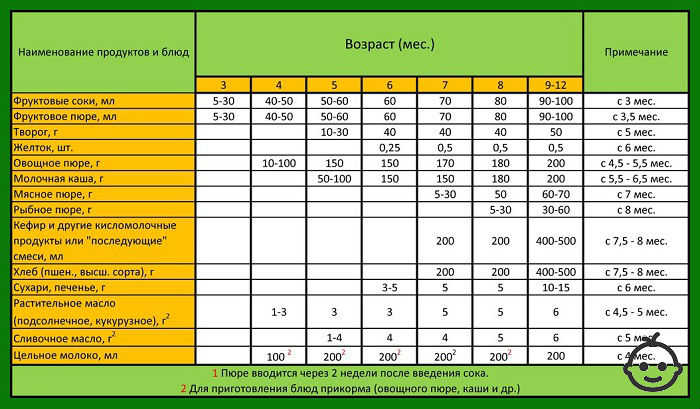
- Age 6 months. One type of complementary food is introduced into the diet. Most often, this is vegetable puree, in some cases it may be porridge. The best vegetables for making purees are zucchini and cauliflower. You can add a couple of drops of vegetable oil to the dish. A single serving gradually increases to 150-200 g and replaces one breastfeeding or formula feeding.
- Age 7 months. If vegetable puree was introduced into the baby’s diet at six months, then porridge is introduced at 7 months and vice versa. The first porridges should be quite liquid and gluten-free. Buckwheat, rice and corn porridges are suitable for complementary feeding. You can buy special ready-made porridges or cook them at home yourself, in which case the cereal is ground using a coffee grinder. At the same age, you can offer your child the yolk of a quail or chicken egg. In this case, the first portion should be microscopic, since the egg can cause allergies.
- Age 8 months. Fruits in the form of puree and fermented milk products, such as natural yoghurts without additives, cottage cheese and kefir, are introduced into the diet. The first portion of cottage cheese is 1 tsp, and yogurt and kefir - about 20 ml. By the year, this amount is increased to 50 g and 100-150 ml, respectively. Add fruit puree starting with a teaspoon and gradually increase to 100-150 g.
- Age 9 months. Add meat puree. Moreover, if the baby categorically refuses it, then you should not insist; it is better to introduce it a little later. The best views Meats for introducing complementary foods are considered to be rabbit, turkey and veal.
- Age 10 months. At 10 months, fish appears in the diet. You should also be careful with it, as it can cause an allergic reaction. They begin their acquaintance with fish with white, low-fat varieties, for example, cod or hake.
- Age 11 months. Different foods are gradually added to the child’s diet. At this time, the baby already has several teeth, so you don’t have to grind food, but cut it into small pieces. Instead of meat puree, it is allowed to give the child a steamed cutlet or meatballs. This diet will teach your baby to chew.
- Age 12 months. It is not worth transferring a child to a common table by the age of one year, but his daily menu should be varied and balanced, including all types of foods allowed at this age.
Rules for complementary feeding when breastfeeding
The rules for complementary feeding during breastfeeding suggest the introduction of new foods no earlier than 6 months. At the same time, it is important to introduce complementary foods in such a way that the child does not refuse the breast. To do this, you should not give him liquid cereals and other foods from a bottle; it is better to do this with a spoon. Feeding begins with a new product, and it is advisable that the child sits. After the baby has eaten complementary foods, he is given breastfeeding. If the baby refuses new food, there is no need to insist; it is better to offer complementary foods later, when he is hungry.
Rules for complementary feeding during artificial feeding
As a rule, complementary foods are introduced earlier during artificial feeding than during natural feeding. Often, a child begins to be fed additionally from 4-5 months. The following rules for complementary feeding during artificial feeding can be distinguished:
- Complementary feeding is not started before the baby is 4 months old;
- the introduction of a new product and the timing of vaccinations should not coincide;
- new products must be ground until completely homogeneous;
- complementary foods are introduced in the first half of the day;
- Artificial babies can be given new foods both from a spoon and from a bottle;
- If a child refuses complementary feeding, you cannot force feed him.
The baby’s transition to “adult” food is a completely new stage in his life. But it is much more exciting for mom! What to feed first? How to change the volume? How to prepare food? How to make the first menu delicious? The complementary feeding table for children under one year old will answer dozens of pressing questions. It was compiled according to the recommendations of WHO and Russian pediatricians.
The requirements for introducing foods into the diet of babies have changed significantly in recent years. Pediatricians no longer insist on the need to give babies juices from two months and cottage cheese from four months. However, the recommendations proposed by the World Health Organization, as well as those enshrined in the official regulations of the Russian Ministry of Health, differ. The latter are allowed to introduce complementary foods as early as four months, and this is done at an accelerated pace.

Schedule up to a year
The recommendations of the Russian Ministry of Health propose a complementary feeding schedule for children up to one year old, which requires the use of vegetables, cereals, cottage cheese and meat, juices, and fruit purees in their diet by seven months. This schedule does not comply with WHO recommendations, which note that diet correction is carried out at six months of age. And only in individual cases and according to individual indications, which include critical delays in weight gain and development, does it make sense to change the child’s diet earlier.
According to WHO, complementary feeding is food designed to meet the increasing energy needs of a baby who is more active and mobile than before. And allowing him to introduce him to a variety of foods. Based on this, the basic principles for correcting the baby’s diet are determined.
- Food is complementary. This is exactly what complementary foods are. The basis of a child’s nutrition is breast milk, and if breastfeeding is impossible, an adapted formula.
- The food is varied. Mothers of eight-month-old babies usually look with horror at the complementary feeding table by month. And they understand that from the recommended products, including meat, kefir, yolk, and several types of vegetables, they managed to accustom the child to at most a couple of vegetable dishes and cereal porridges. But this diversity is only an attempt to show exactly what flavors and types of foods a child can consume due to his physiological development. This is a recommendation about dishes of what consistency, taste, and aroma a child can begin to get acquainted with. The numbers on the tablet should not be taken as a mandatory guide to action, since it is simply impossible to achieve many of them by safely introducing products.
- Foods with high energy density. Based on the fact that complementary feeding should replenish the energy the baby lacks for activity and growth, it is necessary to choose energy-rich foods. These do not include juices previously recommended for the first complementary foods and fruits. A small amount of porridge or vegetables contains much more calories that are significant for the baby.
Energy-rich food does not mean fatty, WHO experts note. A child should not be given animal fat, including milk containing fat, until two years of age. You cannot add salt and sugar to food. The latter saturates the body with “empty” calories and suppresses appetite.
All products that include a scheme for introducing complementary foods by month until the age of one are called transitional. They are adapted to the child's needs in terms of consistency and density. The goal of the process is for the baby to switch to the traditional food of the family table. Therefore, it is wise to use not specially selected products for feeding, but precisely those grains, vegetables, types of meat and fish that are customary to eat in your family.

Table - Complementary feeding of a child by month (WHO recommended schedule)
| Products | 6 months | 7 months | 8 months | 9 months | 10 months | 11-12 months |
|---|---|---|---|---|---|---|
| Vegetable puree, g | 120 | 140 | 150 | 170 | 180 | 200 |
| Cereal porridge, g | 120 | 150 | 180 | 200 | 200 | 200 |
| Vegetable oil, ml | 1 | 3 | 5 | 5 | 5 | |
| Fruit puree, g | 60 | 60 | 60 | 17 | 80 | 80 |
| Meat, g | 50 | 60 | 70 | 80 | ||
| Yolk | 1/4 | 1/4 | 1/2 | |||
| Cottage cheese, g | 30 | 40 | 50 | |||
| Crackers, g | 3 | 5 | 5 | 10 | 10 | |
| Wheat bread, g | 5 | 5 | 5 | 10 | ||
| Butter, g | 1 | 3 | 5 | 5 | ||
| Fish, g | 30 | 50-60 | ||||
| Fruit juice, ml | 30 | 50 | 60 | 80-100 | ||
| Kefir, ml | 30 | 50 | 100 | |||
The table determines the types of complementary foods by month and dosage. It is for informational purposes only. If you continue breastfeeding, it is not recommended to exceed these standards. With artificial feeding, the main source of nutrition in the diet remains formula. The mixed mode allows you to displace the mixture, replacing it with complementary feeding products.
The consistency of the dishes should correspond to the child’s developmental level and existing skills. At the age of up to seven months, babies experience a shift in the gag reflex from the middle of the tongue to its root, and the strength of chewing movements increases. They can eat pureed foods made from gluten-free vegetables, fruits and grains.
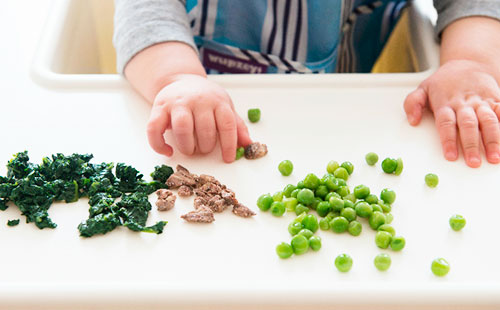
Between the ages of seven months and one year, chewing skills improve. The baby learns to bite, move food with his tongue to his teeth, and remove it from a spoon with his lips. During this period, it is recommended to change the consistency of the dishes. They are served mashed, chopped, and also in a form convenient for eating with your hands.
Only after a year does the stability of the jaws develop, and chewing movements acquire an adult, rotational character. At this time, the child can be transferred to family food.
Product introduction technique
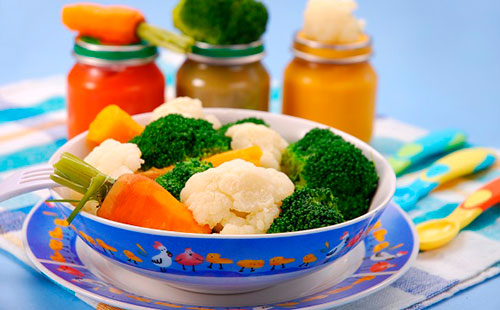
Feeding with vegetables
WHO recommends using zucchini as a baby's first food. It is served boiled, mashed. The second product is cauliflower, the third is broccoli. The scheme for feeding vegetables is as follows.
| Day | Product | Grams | Note |
|---|---|---|---|
| 1 | Zucchini (puree) | 3 | Before the second morning feeding. After breast milk or formula until satiated. Five grams roughly correspond to the capacity of one teaspoon |
| 2 | 10 | ||
| 3 | 20 | ||
| 4 | 40 | ||
| 5 | Zucchini (puree) and vegetable oil | 70 | |
| 6 | 120 | ||
| 7 | 120 | ||
| 8 | Cauliflower and zucchini (puree) with vegetable oil | 3+117 | Prepare two types of puree. They can be mixed by adding a new product to a familiar one. Or give separately |
| 9 | 10+110 | ||
| 10 | 20+100 | ||
| 11 | 40+80 | ||
| 12 | 70+50 | ||
| 13 | Cauliflower (mashed) and vegetable oil | 120 | Complementary feeding with monocomponent cauliflower puree |
| 14 | 120 | ||
| 15 | Zucchini or cauliflower and broccoli (mashed) with vegetable oil | 3+117 | Prepare two types of puree. One is from a familiar vegetable, the other is from broccoli. They can be mixed by adding a new product to a familiar one. Or give separately |
| 16 | 10+110 | ||
| 17 | 20+100 | ||
| 18 | 40+80 | ||
| 19 | 70+50 | ||
| 20 | Broccoli (puree) and vegetable oil | 120 | Complementary feeding with monocomponent broccoli puree |
| 21 | 120 |
Thus, it will take you at least twenty-one days to introduce three vegetables into your child’s diet. After you bring each product to the recommended age limit, you can mix them in the required proportions and offer your baby both single-component and multi-component purees.
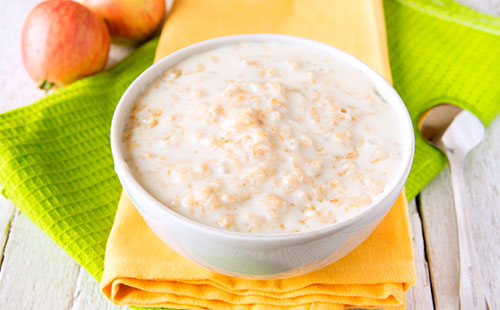
Feeding with cereals
You can start it after introducing vegetables. It is recommended to feed babies with a lag in weight gain with cereals initially. We present the World Health Organization recommended scheme for feeding cereals, starting from the twenty-second day.
| Day | Product | Grams | Note |
|---|---|---|---|
| 22 | Buckwheat (porridge) | 3 | Before the second morning feeding. Existing vegetable complementary foods are transferred to lunch |
| 23 | 10 | ||
| 24 | 20 | ||
| 25 | 40 | ||
| 26 | 70 | ||
| 27 | Buckwheat (porridge) and butter | 120 | |
| 28 | 150 | ||
| 29 | Rice and buckwheat (porridge) with butter | 3+147 | Prepare two types of porridge. They can be mixed by adding a new product to a familiar one, or given separately |
| 30 | 10+140 | ||
| 31 | 20+130 | ||
| 32 | 40+110 | ||
| 33 | 70+80 | ||
| 34 | 120+30 | ||
| 35 | Rice (porridge) and butter | 150 | Complementary feeding with monocomponent rice porridge |
| 36 | Corn and rice/buckwheat (porridge) with butter | 3+147 | Prepare two types of porridge. One from familiar cereals, the second from corn. They can be mixed by adding a new product to a familiar one. Or give separately |
| 37 | 10+140 | ||
| 38 | 20+130 | ||
| 39 | 40+110 | ||
| 40 | 70+80 | ||
| 41 | 120+30 | ||
| 42 | Corn (porridge) and butter | 150 | Complementary feeding with monocomponent corn porridge |
The period of introduction of porridges takes three weeks. At this time, the baby is seven and a half months old, so it is too early to introduce meat into his diet. The World Health Organization recommends including new foods from the group of vegetables and cereals in the complementary feeding of the newborn every month at this stage.
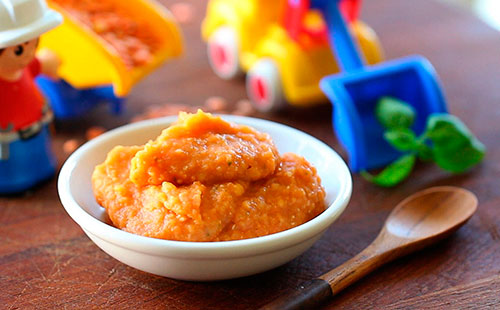
New products
| Day | Product | Grams | Note |
|---|---|---|---|
| 43 | Pumpkin and familiar vegetable puree with vegetable oil | 3 + 137 | Introduced at lunch. For second breakfast, the baby eats cereal porridge |
| 44 | 10 +130 | ||
| 45 | 20 + 110 | ||
| 46 | 40 +100 | ||
| 47 | 70 +70 | ||
| 48 | 120 + 20 | ||
| 49 | Pumpkin (puree) with vegetable oil | 140 |
After introducing pumpkin, you can begin fruit feeding. In the middle of the seventh month, it’s time to introduce your baby to the apple. The recommendation of pediatricians to introduce this product right now is simple. The fruit has a distinct taste that can be perceived by a child with more enthusiasm than the neutral taste of zucchini. In the future, the baby, having tried fruits rather than vegetables for the first time, may simply refuse the latter.
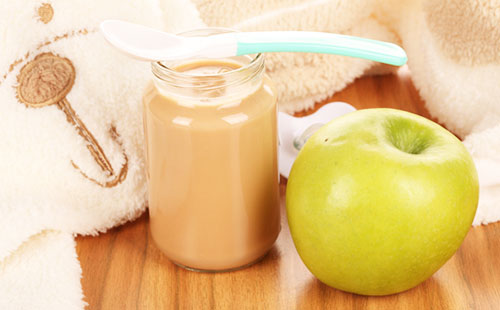
The next step towards the end of the seventh month may be the introduction of a new cereal. The child’s digestive tract is ripe for acquaintance with millet porridge.
| Day | Product | Grams | Note |
|---|---|---|---|
| 56 | Millet and familiar cereals (porridge) with butter | 3 + 147 | Served for breakfast. Prepare two types of porridge. They can be mixed, adding a new product to a familiar one, or given separately. Additionally, the child eats applesauce for breakfast. |
| 57 | 10 +140 | ||
| 58 | 20 + 130 | ||
| 59 | 40 +110 | ||
| 60 | 70 +80 | ||
| 61 | 120 + 30 | ||
| 62 | Millet (porridge) with butter | 150 | |
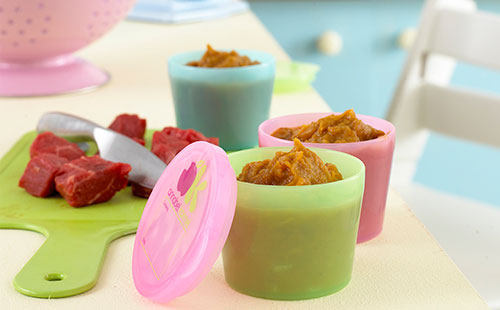
Complementary feeding with meat
At eight months, the child’s diet consists of four types of grains in the form of dairy-free porridges, four vegetables and an apple. During this period, it is recommended to include meat in the menu that is well-cooked, ground in a meat grinder twice, or ground. According to WHO recommendations, the first meat should be rabbit fillet, as the least allergenic and low-fat product.
A meat product is rarely accepted by a child right away. You can mix small portions of it with porridge. In this case, the baby will not notice it in minimal initial doses. When the volume increases, the taste of meat will seem familiar to the baby, and he will be less likely to refuse it.
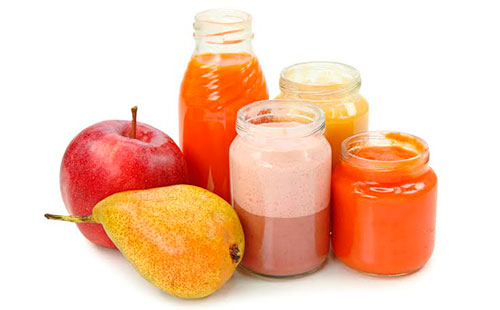
Fruits serve as a source of vitamins throughout the year and stimulate intestinal function. To normalize digestion after introducing meat, WHO experts recommend introducing prunes as the next step.
| Day | Product | Grams | Note |
|---|---|---|---|
| 70 | Prunes and apple (puree) | 3 +57 | |
| 71 | 8 +52 | ||
| 72 | 16 +44 | ||
| 73 | 25 + 35 | ||
| 74 | 35 +25 | ||
| 74 | 50 +10 | ||
| 76 | 60 |
Thus, the child has a rich breakfast of cereals and fruits, and an equally rich lunch of vegetable puree and meat.
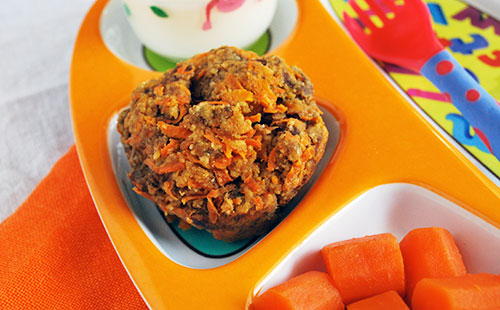
Expansion of meat feeding
| Day | Product | Grams | Note |
|---|---|---|---|
| 77 | Turkey and rabbit (meat puree) | 3 +47 | Introduced for breakfast in addition to porridge. Fruit puree is carried over to lunch, offered to the child after vegetable puree |
| 78 | 8+42 | ||
| 79 | 15+25 | ||
| 80 | 20+30 | ||
| 81 | 30+20 | ||
| 82 | 40+10 | ||
| 83 | 50 |
Despite the fact that the child is already familiar with a large number of products, new ones are still used during the second breakfast in the first half of the day. This requires periodic adjustments to the usual menu for breakfast and lunch, but it is necessary to notice in time a reaction to a new component of the diet if it occurs.
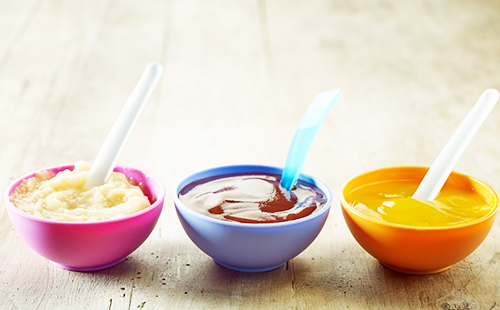
Expansion of fruit feeding
The next type of fruit recommended is pear. However, this is not important; you can introduce any new fruit in your area, for example, apricot, peach. Or try feeding your baby a banana, which children usually eat with joy.
| Day | Product | Grams | Note |
|---|---|---|---|
| 84 | Pear and apple (puree) | 3 +57 | Introduced for breakfast in addition to porridge and familiar fruit puree. Can be mixed with apple or served separately. The baby continues to eat vegetable puree for lunch; meat puree is added to it |
| 85 | 8 +52 | ||
| 86 | 16 +44 | ||
| 87 | 25 + 35 | ||
| 88 | 35 +25 | ||
| 89 | 50 +10 | ||
| 90 | 60 |
The first ninety days, as the complementary feeding table shows, are very eventful. Don't be upset if you can't stick to the schedule or your baby refuses to eat that much food. Your task is to diversify its menu with new tastes in order to get to know them. Therefore, every week there is a new product in the diet.
In the future, other types of complementary foods recommended for the baby’s age are introduced in a similar manner. The new one is offered exclusively for breakfast. As fermented milk products are included in the diet, the child will have an afternoon snack, which will include fruit puree. Crackers and baby cookies are offered as snacks throughout the day. After introducing fish, it is alternated in the diet with meat, without being offered on the same day.
Earlier introduction of complementary foods is undesirable. The child’s body is not ready for this yet. Newborn babies have an innate tongue thrust reflex. If solid food or a spoon gets into the baby's mouth, he will push it out with his tongue. This is probably designed by nature to prevent suffocation. By 6 months this reflex fades away. By the same age, the enzymatic and motor functions of the digestive system mature. Let us consider in detail how to properly introduce complementary foods at 6 months while breastfeeding according to the recommendations of the World Health Organization.
6 months
So, having realized that your baby is ready for complementary feeding, start introducing him to vegetable puree. Starting from 5g. new product per day, in a week increase its volume to 100-130 grams. Naturally, when introducing complementary foods, you need to focus on the health of the child and his individual development. Nevertheless, the diagram below for the phased introduction of products will allow you to understand the algorithm for gradually introducing the baby to complementary foods.
Table for introducing complementary foods by month
| 6 months | |
| 1 day | 5g. zucchini puree |
| Day 2 | 10 gr. zucchini puree |
| Day 3 | 20 gr. zucchini puree |
| 4 day | 40 gr. zucchini puree |
| 5 day | 60 gr. zucchini puree |
| Day 6 | 80 gr. zucchini puree |
| Day 7 | 100gr. zucchini puree |
| 6 months 2 weeks | ||
| 1 day | 5g. cauliflower | 95 gr. zucchini puree |
| Day 2 | 10 gr. cauliflower | 90 gr. zucchini puree |
| Day 3 | 20 gr. cauliflower | 80 gr. zucchini puree |
| 4 day | 40 gr. cauliflower | 60 gr. zucchini puree |
| 5 day | 60 gr. cauliflower | 40 gr. zucchini puree |
| Day 6 | 80 gr. cauliflower | 20 gr. zucchini puree |
| Day 7 | 100gr. cauliflower | - |
| 6 months 4 weeks | ||
| Breakfast | Dinner |
|
| 5 gr. buckwheat | 130 gr. vegetable puree |
|
| 10 gr. buckwheat | 130 gr. vegetable puree |
|
| 20 gr. buckwheat | 130 gr. vegetable puree |
|
| 40 gr. buckwheat | 130 gr. vegetable puree |
|
| 60 gr. buckwheat | 130 gr. vegetable puree |
|
| 80gr. buckwheat | 130 gr. vegetable puree |
|
| 100gr. buckwheat | 130 gr. vegetable puree |
|
At the end of the article, we have prepared additional material for you - a video from a practicing pediatrician with 20 years of experience on how to properly introduce complementary foods to your baby!
| 7 months | |||
| Breakfast | Dinner |
||
| 5 gr. rice | 95 gr. buckwheat | 140 gr. vegetable puree |
|
| 10 gr. rice | 90 gr. buckwheat | 140 gr. vegetable puree |
|
| 20 gr. rice | 80 gr. buckwheat | 140 gr. vegetable puree |
|
| 40 gr. rice | 60 gr. buckwheat | 140 gr. vegetable puree |
|
| 60 gr. rice | 40 gr. buckwheat | 150 gr. vegetable puree |
|
| 80gr. rice | 20 gr. buckwheat | 150 gr. vegetable puree |
|
| 100gr. rice | 10 g buckwheat | 150 gr. vegetable puree |
|

Then, using the same principle, introduce dairy-free corn porridge for breakfast in the middle of the seventh month, along with rice and buckwheat alternately. For lunch, vegetable puree from familiar products: either mono-component one at a time, or a mix in a volume of 150 g.
At 7 months 4 weeks, introduce fruit puree (apple, pear, prunes) for breakfast in a similar volume increase, starting with 5g. and bringing it to 50 grams by the seventh day. Start adding 1 tsp to vegetables. vegetable oil. Increase the volume of porridge for breakfast to 140-150 g.
8 months
At this time, add pumpkin. For breakfast, continue preparing porridge, alternating buckwheat, corn and rice cereals. For lunch - vegetable soup - 150 gr.
8 months 2 weeks. For breakfast, introduce millet porridge, gradually increasing the volume from 5 to 150 g. in a week. For lunch - vegetables 150g, fruit juice - 20g.
Around this time, an afternoon snack appears: 50g. fruit puree.
In the middle of the eighth month, you can introduce your baby to fermented milk products. Starting with 5 ml of kefir, increase to 50 ml. in a week. For lunch - vegetables 150g, afternoon snack - 50g. fruit puree
8 months 4 weeks. For breakfast: any of the already familiar cereals, porridge 150 g. with 5 gr. butter, 30 gr. - fruit puree. And the egg - start with 1/6 of the yolk, give it every other day, bringing it up to 1/2 in a week. Egg white It is highly allergenic; do not give it to a child under 1 year of age. For lunch - vegetables 150g, afternoon snack - kefir 50ml with 1 children's cookie.
9 months
Time for meat! Start with turkey or rabbit meat. Similarly: introducing complementary foods with 5 grams. meat puree, and by the end of the week gradually increase to 50 grams. First, offer meat for breakfast, as an addition to porridge. Next, add to soup cooked in vegetable broth. Introduce meat broths into the child’s diet after the first year of life. In the middle of the ninth month, introduce the baby to potatoes, but the volume of the final portion after increasing the volume should not exceed 50 grams. at one time, due to the starch content in potatoes. In the third week of this month, introduce oatmeal into your baby's diet. Continue to prepare dairy-free porridges. It is advisable that neither cow nor goat milk be present in the baby’s diet until at least 1 year of age.
10 months
Time to introduce your child to fish and its low-fat varieties. Starting with 0.5 teaspoon in the morning and increasing to 50-60 g. in 1-2 weeks. The period of introduction of fish can be increased to 2 weeks. Do not rush to increase the volume of fish puree, as children are often allergic to excessive introduction of this product into the diet. Next, feed fish 2 times a week, alternating with meat.
11-12 months
By this time, the baby is familiar with most of the products of the usual family diet. Continue to introduce all new products in the morning. Further, when the baby adapts to them, you can offer them at any meal.

In addition, the baby already has his first few teeth, and he actively wants to use them. Replace puree with food with small soft pieces, offer meat in the form of meatballs, mash vegetables in soup with a fork, grate fruit, and make various casseroles.
Gradually replace one of your breastfeedings with a meal. Approximate diet The nutrition of a breastfed baby aged 1 year may look like this:
Watch the video from our partner Test.tv on this topic
Watch a video from a practicing pediatrician with 20 years of experience on how to properly introduce complementary foods to your baby. Get more useful materials on the development and upbringing of children to your email



